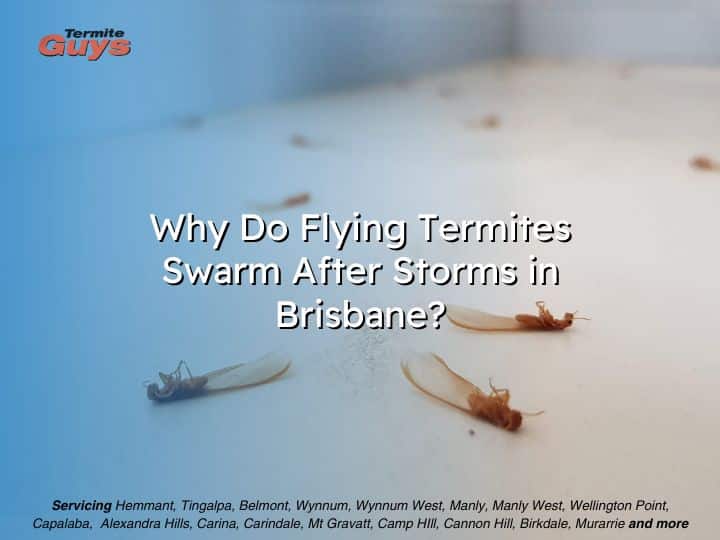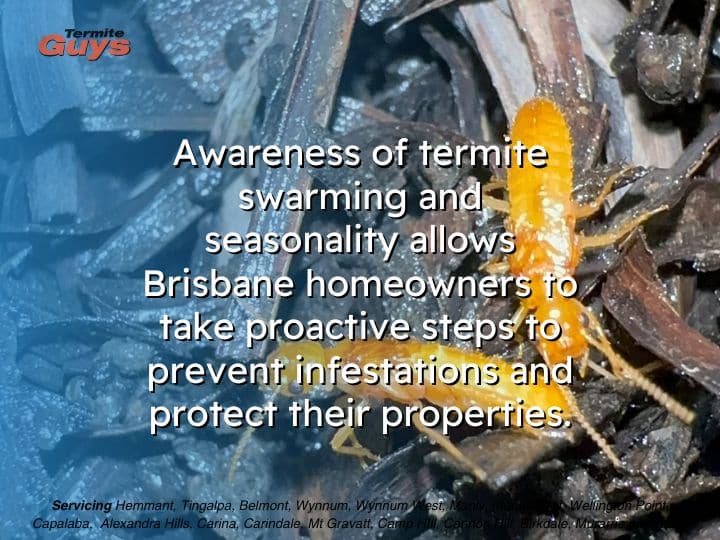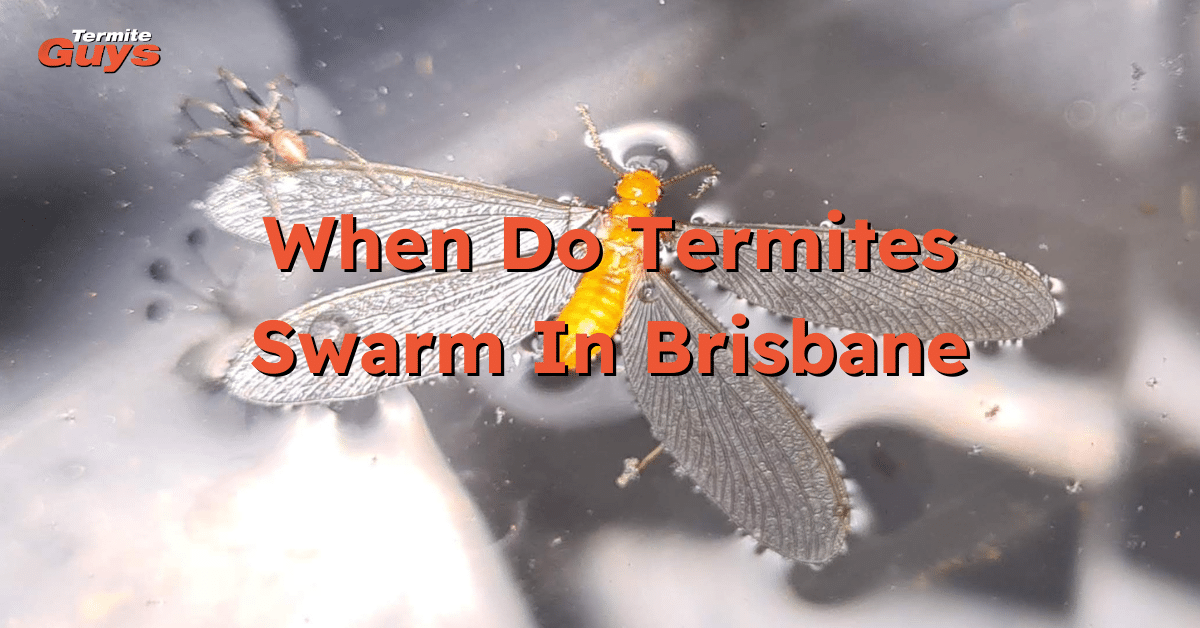Uncovering the Secrets Behind Termite Swarming and Seasonality!
Termite swarming is one of the surest signs of termite activity near your home in Brisbane. But when exactly do termites swarm, and why does this happen mostly after storms and in certain seasons? Understanding termite swarming and seasonality in Brisbane is key to protecting your property from costly termite damage.
If you see termites swarming in Brisbane during October or November, it’s a serious warning sign that a nest is nearby. Flying termites are nature’s way of telling you your home could soon be at risk. The best prevention is installing a professional termite barrier to keep them out. That’s why calling Termite Guys Brisbane is so important. Don’t wait until damage occurs—act now. Call 07-3393-3515 or email admin@termiteguys.com.au
Termite swarming in Brisbane is triggered by warm, humid conditions that create the perfect environment for flying termites – known as alates – to leave their colonies and start new ones. Key points about termite swarming include:
It mainly occurs during late spring to early summer (November to March) when temperatures rise.
Swarms are especially common after heavy rain or storms, with increased humidity and moisture.
Flying termites are attracted to lights, which often brings them close to homes.
Knowing these triggers can help homeowners spot termite swarms early and take action to prevent infestations.
What Triggers Termite Swarming in Brisbane?
Termite swarming is not random; it is triggered by specific environmental conditions that signal the right time for the reproductive termites to fly out and form new colonies.
In Brisbane, the main triggers for termite swarming include:
High humidity levels that prevent termites from drying out during flight.
Recent rainfall or storms that saturate the soil and increase moisture availability.
Warm temperatures in late spring and summer that activate termite colonies.
Mature termite colonies that are ready to reproduce and spread.
These environmental factors come together mostly between November and March in Brisbane’s subtropical climate. After a wet period or storm, the ground is softened, and termites have the moisture they need to build new nests. The warm air temperature encourages alates to swarm, mate, and colonize new areas.
Triggers that start the swarming
Termite swarms happen when colonies reach maturity, often several years old.
Storms create perfect conditions by increasing soil moisture and humidity.
Warm, humid summers in Brisbane extend the swarming season.
Swarming usually occurs in the late afternoon or early evening.
Termites fly only for short distances to establish new colonies nearby.
Mature colonies can produce thousands of swarmers at once.
Questions clients ask
When do termites swarm in Brisbane?
Termite swarming in Brisbane typically happens from late spring to early summer (November to March), especially after heavy rains or storms when humidity is high.
Why do termites swarm after rain?
Rain increases soil moisture and humidity, which are critical for termite survival during flight. After rain, conditions are optimal for alates to swarm and find a new place to establish a colony.
Why Do Flying Termites Swarm After Storms in Brisbane?
Storms and heavy rainfall are common catalysts for termite swarming in Brisbane. But why does this weather trigger swarms?
Storms saturate the soil and boost humidity – two critical survival factors for termites when they take flight. The moisture softens the ground to facilitate new nest construction, and the humid air reduces the risk of dehydration during their short mating flight. After heavy rains, termite colonies sense the optimal environment outside and release thousands of winged termites simultaneously. This behavior ensures the best chances for successful reproduction and colony expansion.

What triggers swarming
Soil moisture is essential for termites to build new nests.
High humidity during and after storms helps flying termites survive.
Storms create environmental cues signaling ideal breeding conditions.
Swarming after storms reduces termite exposure to dry conditions.
Termite activity increases when rainwater saturates timber and soil.
The period after storms marks peak termite reproductive activity in Brisbane.
Questions related to storms and swarming
How do storms affect termite swarming?
Storms increase moisture in the soil and air, creating ideal conditions for termites to swarm and start new colonies with a lower risk of dehydration.
What happens if termites swarm after heavy rain?
After heavy rain, termites swarm en masse to find suitable nesting sites. This can increase the risk of termite infestation near homes due to the abundance of flying alates.
Why Are Flying Termites Attracted to Light and What Does This Mean for Brisbane Homeowners?
One noticeable behaviour of flying termites (alates) is their strong attraction to light sources at dusk or after dark. This attraction is a key reason why many homeowners first see swarms near doorways, windows, and outdoor lighting.
Flying termites use light cues to navigate during their mating flights. Artificial lights, such as porch lamps and indoor lights, confuse these insects and draw them closer to homes. While this may seem like a nuisance, it is a warning sign of nearby termite colonies. Swarming near lights means alates are actively seeking mates and suitable nesting locations, making it important for homeowners to stay vigilant and take protective measures.
What causes this attraction
Termites use natural light for navigation, but artificial lights confuse them.
Bright outdoor and indoor lights attract swarming termites close to homes.
Attraction to light increases the chance termites enter houses.
Flying termites shed wings after landing to start new colonies.
Homeowners should reduce outdoor lighting during swarming season to minimize attraction.
Swarms near lights indicate active and mature colonies nearby.
Questions related to light
Why do termites swarm around lights?
Flying termites are attracted to light as it helps them navigate during their mating flights, making artificial lights a beacon that pulls them closer to homes.
What does termite swarming near lights mean?
Swarming near lights signals active termite colonies nearby and an increased risk of infestation, urging homeowners to inspect for termites.
How Can Brisbane Homeowners Protect Themselves During Termite Swarming Season?
Awareness of termite swarming and seasonality allows Brisbane homeowners to take proactive steps to prevent infestations and protect their properties. Regular inspections by professionals ensure early detection before termites cause structural damage.
Key protective measures include:
Scheduling termite inspections annually or biannually, especially before and during swarming season.
Reducing outdoor lighting during peak swarming times to minimize attractants.
Fixing leaks and improving drainage to reduce moisture around the house.
Removing timber, mulch, and debris near the foundation to eliminate termite habitats.
Treating properties with termite barriers and chemical treatments as recommended.
Monitoring for signs like winged termites, mud tubes, and damaged wood.

Supporting tips
Professional inspections catch termite activity before damage occurs.
Light management reduces flying termite attraction.
Moisture control deprives termites of their preferred environment.
Preventive treatments protect homes long-term.
Early action reduces costly wood repairs.
Educating household members helps in spotting termite signs early.
Related questions
What steps help prevent termite infestations during swarming?
Regular inspections, reducing outdoor lights, fixing leaks, and maintaining clear surroundings can help keep termites away during swarming season.
When should Brisbane homeowners get termite inspections?
It is best to schedule inspections annually or just before termite swarming season, typically in late spring, to catch any termite activity early.
What Are the Signs of Termite Swarming Homeowners Should Watch For?
Recognizing termite swarming signs is critical for timely termite control. Brisbane homeowners should watch for:
Winged termites (alates) near windows, doors, or light fixtures.
Discarded wings on windowsills or around the home.
Small mud tubes on walls or foundations indicating termite tunnels.
Hollow-sounding timber or visible wood damage.
Increased termite activity following heavy rains.
Early detection through these signs can prevent extensive property damage and more expensive treatment later on.
What to look out for
Winged termite sightings often precede a new infestation.
Mud tubes protect termites from exposure while traveling.
Presence of discarded wings shows recent swarming and colony activity.
Damaged wood or soft spots indicate termite feeding.
Regular monitoring after storms is crucial.
Immediate pest control consultation needed if signs appear.
Client questions answered
What signs show termites are swarming near my home?
Look for winged termites flying near lights, discarded wings on surfaces, and mud tubes along walls or foundations.
How can I identify if termites have started damaging my house?
Signs include hollow or damaged wood, blistering paint, and visible mud tubes, often noticed after termite swarms.
FAQ
1. When is termite swarming season in Brisbane?
Termite swarming in Brisbane mainly occurs from November through March during warmer, humid months.
2. Why do termites swarm after rainstorms?
Rainstorms increase soil moisture and humidity, creating ideal conditions for termites to fly and start new colonies.
3. Are flying termites dangerous to homes?
Flying termites themselves don’t cause damage, but their presence indicates nearby colonies capable of causing serious damage.
4. How can I stop termites being attracted to my outdoor lights?
Use yellow or sodium vapor bulbs and turn off unnecessary lights during swarming season to reduce attraction.
5. What should I do if I see a termite swarm near my home?
Contact a professional termite inspection service immediately to assess and treat any infestations early.
Termite swarming and seasonality in Brisbane revolve around warm, humid weather and recent storms that create ideal conditions for termites to reproduce and spread. Flying termites’ strong attraction to light often signals nearby colonies and potential infestations. For Brisbane homeowners, understanding these patterns is vital to early detection and prevention.
When it comes to termite inspections and termite control in Brisbane, Termite Guys Brisbane is the best company to call. With expert knowledge of local termite behaviour and advanced treatment methods, they ensure thorough inspections and effective termite protection tailored for Brisbane homes. Their commitment to professionalism and timely service gives homeowners peace of mind and a termite-free property year-round.
Protect your home by staying informed about termite swarming and seasonality and rely on trusted professionals like Termite Guys Brisbane to safeguard your investment.


